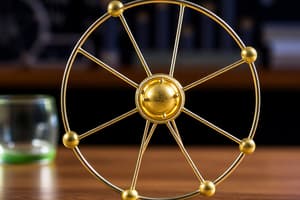Podcast
Questions and Answers
What is the correct form of a hypothesis?
What is the correct form of a hypothesis?
Which of the following elements is NOT considered essential to life?
Which of the following elements is NOT considered essential to life?
Which statement accurately describes an exothermic reaction?
Which statement accurately describes an exothermic reaction?
What is the primary purpose of enzymes in chemical reactions?
What is the primary purpose of enzymes in chemical reactions?
Signup and view all the answers
Which factor does NOT impact chemical reactions?
Which factor does NOT impact chemical reactions?
Signup and view all the answers
What is the main role of ATP in cellular processes?
What is the main role of ATP in cellular processes?
Signup and view all the answers
What type of bond is predominant in water molecules?
What type of bond is predominant in water molecules?
Signup and view all the answers
What correctly describes passive transport mechanisms?
What correctly describes passive transport mechanisms?
Signup and view all the answers
Study Notes
Unit 1 Notes
- Scientific Design Steps: A process involving observation, forming a hypothesis, testing the hypothesis, and drawing conclusions.
- Hypothesis Formation: "If...then" statements, predicting what will happen under specific conditions.
- Observation vs. Inference: Observation is direct information collected, while inference is a conclusion based on observation.
- Accuracy vs. Precision: Accuracy refers to closeness to the true value, while precision refers to how repeatable the measurements are.
- Independent Variable: The variable that is being changed or manipulated in an experiment.
- Dependent Variable: The variable that is being measured or observed in an experiment.
Atomic Structure
- Proton: Positively charged particle in an atom's nucleus.
- Neutron: Neutrally charged particle in an atom's nucleus.
- Electron: Negatively charged particle orbiting the nucleus.
- Atomic Structure Diagram: Illustrate the arrangement of protons, neutrons, and electrons in an atom.
How to Calculate Subatomic Particles
-
Finding the number of protons, neutrons, and electrons in an atom.
- Protons = atomic number
- Electrons = protons (in a neutral atom)
- Neutrons = mass number - atomic number
Chemical Structure
- Smallest to Largest Atoms: Listing elements in order of size.
- Essential Elements: Specific elements that are crucial for organisms' survival(ex., C, H, O, N, P, S).
Properties of Water
- How Water Bonds/Draw: Illustrate the covalent bonds between atoms within a water molecule.
- Properties of Water: The special properties of water that are significant for life.
Cell Theory (Unit 11)
- Organelles and Functions: Describing the roles of cell organelles for cellular activity.
- Cell Membrane: The outer boundary of a cell, regulating the passage of materials.
- Cytoskeleton: The framework of a cell.
- Cytoplasm: The fluid inside the cell.
- Nucleus: Control Center of the cell.
- Nucleolus: Inside the nucleus where ribosomes are made.
- Ribosomes: Structures responsible for protein synthesis.
- Rough ER: Ribosomes attached to its surface Involved in protein synthesis and modified.
- Smooth ER: Non-ribosomal ER involved in lipid synthesis and detoxification.
- Vesicles: Membrane-bound sacs for transporting materials within the cell or into/out of a cell.
Osmosis
- Osmosis Examples: Draw diagrams showcasing the movement of water across a semipermeable membrane in response to differences in solute concentration.
Cell Cycle (Unit 11)
- Interphase: The phase of the cell cycle where growth and DNA synthesis occur.
- Cell cycle checkpoint: Points in the cell cycle where cells regulate their progression.
- Mitosis: Cellular division process.
- Cytokinesis: Cytoplasmic division in mitosis forming two new cells.
Transport
- Passive vs Active Transport: Compare and contrast different mechanisms by which materials move across cell membranes, including the energy requirements.
Chem Reactions (Unit 11)
- Endothermic vs Exothermic: Endothermic reactions absorb energy, and exothermic reactions release energy.
- Drawing & labeling ATP Structure: Visualization of the structure.
- Purpose of Enzymes: Catalyst in chem reactions by lowering activation energy.
- Factors Affecting Chemical Reactions: Factors impacting chemical reactions speed.
- Purpose of ATP Synthase: How the synthesis/break down of ATP is involved in energy production.
- Drawing & labeling the ATP-ADP Cycle: Visualization of the cycle.
Studying That Suits You
Use AI to generate personalized quizzes and flashcards to suit your learning preferences.
Related Documents
Description
This quiz covers the fundamental concepts of scientific design and atomic structure. You will test your knowledge on hypothesis formulation, variables in experiments, and the basic particles that make up an atom. Prepare to explore the key terminology and concepts of this unit!



